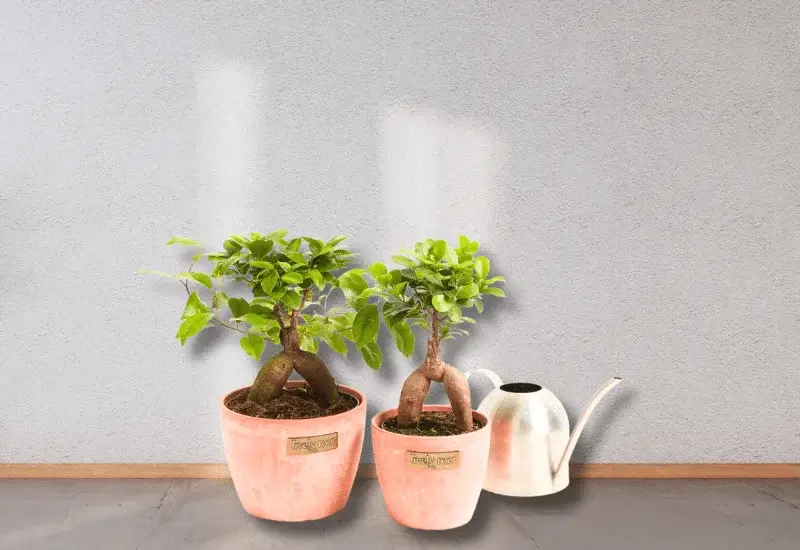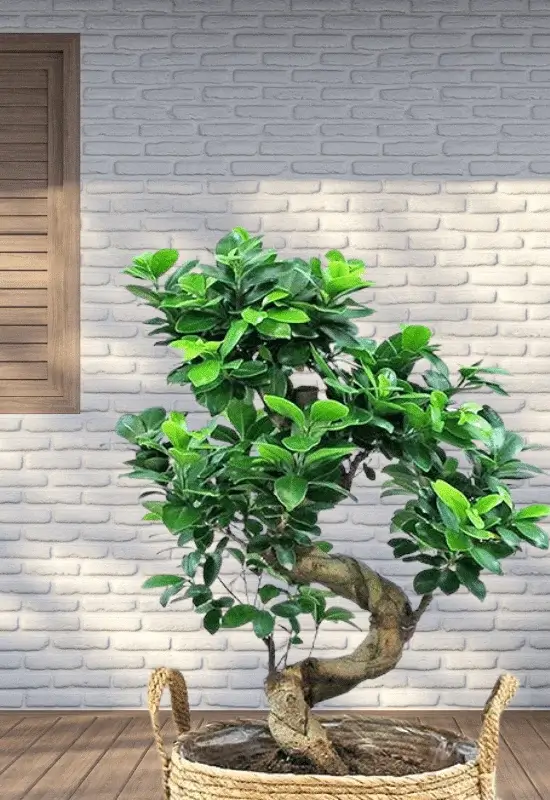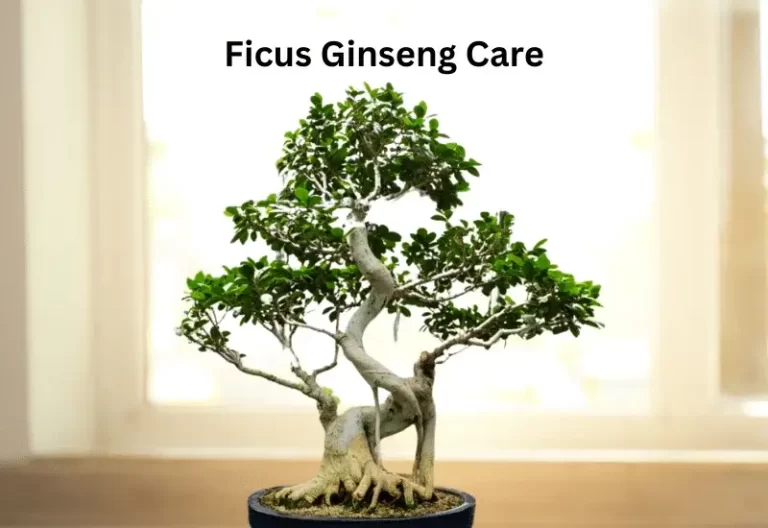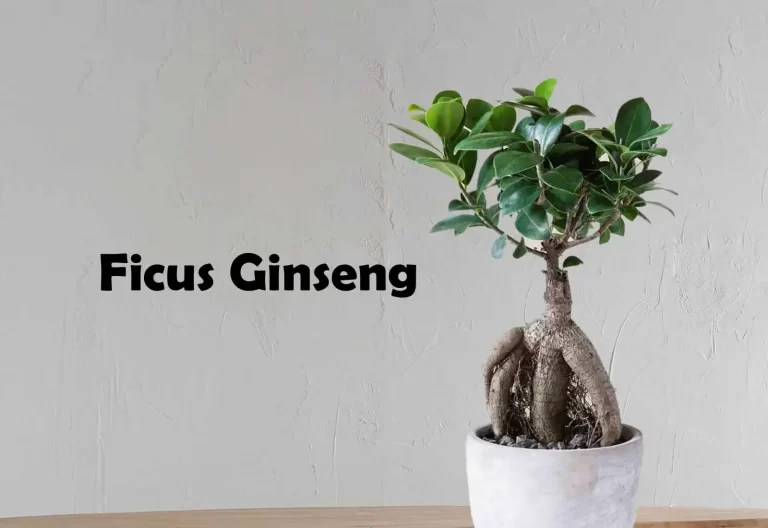How To Grow Ficus Ginseng Bonsai
Ficus Ginseng Bonsai is a captivating and petite tree that touches nature’s artistry into your living space. These bonsai trees have become famous for their charming, miniature appearance and the calming influence they can have on any room.
| Primary Information | |
| Origin | Southeast Asia |
| Size | 6-12 inches |
| Light Needs | Indirect light |
| Temperature Range | 65-75°F (18-24°C) |
| Soil Type | Well-draining bonsai soil |
| Watering | Allow soil to slightly dry |
| Pruning/Shaping | For aesthetics and size |
| Fertilizing | Balanced, diluted fertilizer |
| Repotting | Every 2-3 years in spring |
| Common Pests | Scale, aphids, mealybugs |
| Aesthetic Styles | Upright, Slanting, Cascade, Windswept |
Botanical features and origin
The Ficus Ginseng, also known as the “Ginseng Fig” or “Microcarpa Ficus,” hails from Southeast Asia and has striking, glossy, dark green leaves. This bonsai boasts a unique, bulbous trunk that stores water, adding to its character.
Ideal growing conditions
To thrive, Ficus Ginseng Bonsai prefers lots of bright, indirect sunlight. They enjoy warmth but can handle a range of temperatures. Proper Watering is critical – let the soil dry a bit before rehydrating. Remember that these bonsai trees can adapt to different environments, making them suitable for beginners.
Read Also: Best Soil For Ficus
Care and Maintenance for ficus ginseng bonsai

Watering, pruning, and shaping
- Water Ficus Ginseng when the top inch of the soil feels dry, not soggy.
- Ensure proper drainage to prevent root rot.
- Prune to shape and size, and remove dead or unhealthy growth.
- Use wire to guide branches and shape your bonsai over time.
- Avoid severe pruning in late autumn or winter.
- Be patient; bonsai shaping is a gradual process.
Fertilizing and repotting
- Fertilize in the growing season (spring through summer).
- Use a balanced, diluted liquid fertilizer monthly.
- Repot every 2-3 years during spring to refresh soil and encourage root health.
- Avoid over-fertilization, as it can harm the tree.
- Check if your bonsai needs repotting by examining its roots.
- Replace some of the old soil with fresh bonsai soil.
Pest and disease management
- Regularly inspect your bonsai for signs of pests or diseases.
- Common pests include scale, aphids, and mealybugs.
- Treat infestations with appropriate remedies, such as neem oil or insecticidal soap.
- Prevent diseases by maintaining good airflow and avoiding overwatering.
- Isolate infected bonsai to prevent spreading.
Styling and Design of ficus ginseng bonsai

Ficus Ginseng Bonsai offers a canvas for various bonsai styles, each with its charm. Some popular styles to consider include:
Popular bonsai styles
Informal Upright: A classic style with a straight trunk that gently tapers towards the top.
Slanting: The trunk slants at an angle, creating a sense of movement and resilience.
Cascade: This style imitates a tree growing from a cliff, with branches cascading downward.
Windswept: Mimicking the effects of strong winds, branches are bent in one direction, giving the tree a unique character.
Aesthetic considerations
Achieving an aesthetically pleasing Ficus Ginseng Bonsai involves:
Balance and Proportion: Ensure the tree’s height, size, and shape harmonize.
Create a Focal Point: Emphasize a striking feature or branch for visual interest.
Choose Suitable Pots and Displays: Select containers that complement your bonsai’s style and size.
Adapting care for seasons
Ficus Ginseng Bonsai’s care should adapt to the changing seasons:
Spring and Summer: The growing season requires more sunlight, regular fertilization, and proper Watering.
Autumn: Begin reducing fertilizer and watering slightly as the tree prepares for winter.
Winter: Protect the tree from extreme cold, limiting Watering and ensuring it gets adequate light.
Common issues and solutions
Overwatering
Symptoms: Yellowing leaves, root rot, and a foul smell from the soil.
Solution: Allow the soil to dry out between waterings and ensure proper drainage in the pot.
Underwatering
Symptoms: Wilting leaves, crispy edges, and soil pulling away from the pot’s edges.
Solution: Water the bonsai when the top inch of soil is dry, and consider a humidity tray to maintain moisture.
Pest Infestations (scale, aphids, mealybugs)
Symptoms: Tiny insects on the leaves or branches, honeydew secretion, and yellowing leaves.
Solution: Treat with neem oil or insecticidal soap, and isolate infected bonsai to prevent spreading.
Diseases (fungal issues)
Symptoms: Spots on leaves, mold, or discoloration.
Solution: Improve airflow around the bonsai, avoid overwatering, and apply appropriate fungicides if necessary.
Leaf Drop (Seasonal)
Symptoms: Ficus Ginseng may naturally lose leaves during seasonal changes.
Solution: Monitor for new growth and maintain consistent care practices.
Improper Pruning
Symptoms: Unsightly growth patterns or damage from pruning mistakes.
Solution: Be cautious when pruning, and seek guidance on proper techniques if unsure.
Root-Bound
Symptoms: Slower growth, lack of new leaves, and roots encircling the root ball.
Solution: Repot the bonsai to refresh the soil and prevent root entanglement.
Yellowing Leaves
Symptoms: Yellow leaves with green veins.
Solution: Adjust your fertilization routine or use a balanced, diluted fertilizer as recommended.
Final Words
Growing a Ficus Ginseng Bonsai is a rewarding and creative journey. It is crucial to its success to understand its unique features, maintain it with proper care and aesthetics, adapt to the seasons, and troubleshoot common issues. While the art of bonsai may take time to master, with patience and dedication, you can create a miniature work of art and experience the beauty of nature.




